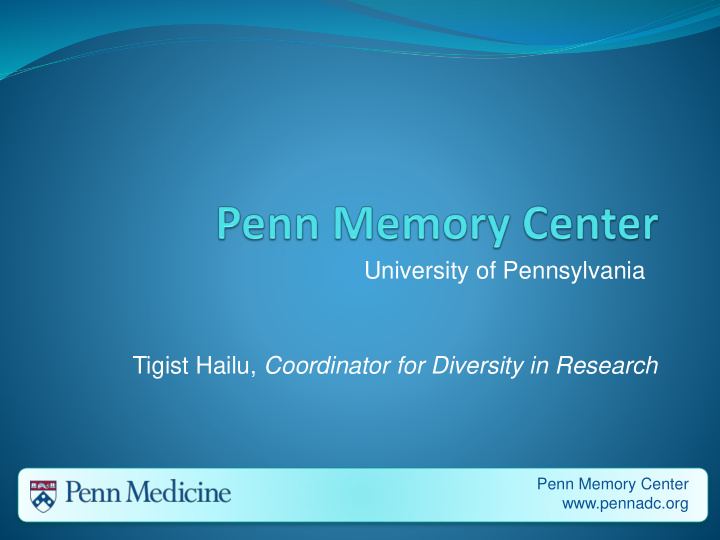



University of Pennsylvania Tigist Hailu, Coordinator for Diversity in Research Penn Memory Center www.pennadc.org
Overview What is the Penn Memory Center? What is the difference between dementia and Alzheimer’s disease? What you can do to delay cognitive decline? Why is research important? What is the NACC study?
“ I want to do whatever I can , so that no other family will have to go through what we are going through” - Vivian Wheeler, PMC Research Participant Karen Wheeler Vivian Wheeler
Penn Memory Center National Institute on Aging designated Alzheimer’s disease center One of 30 such sites in the nation and the only site in our tri-state region Interdisciplinary center (neurologists, psychologists, psychiatrists, geriatricians, social workers, and research coordinators)
What is Dementia? Generic term that describes a number of different diseases Causes: Alzheimer’s disease, Vascular dementia, Dementia with Lewey Bodies, Parkinson’s disease, and Frontotemporal dementia Not part of normal aging
Ten Warning Signs of Dementia 1. Memory loss that affects daily life 2. Difficulty in planning or solving problems Difficulty completing familiar tasks at home or work 3. Confusion with time and place 4. 5. Trouble understanding visual images and spatial relationships New problems with words in speaking or writing 6. Misplacing things and losing the ability to retrace steps 7. Decreased or poor judgment 8. 9. Withdrawal from work or social activities 10. Changes in mood or personality
Alzheimer’s Disease Irreversible, progressive brain disease that slowly destroys memory and thinking skills Advances by stages, from early to mild forgetfulness to severe dementia Risk Factors: Age, family history, and genetics No known cause – No known cure
Why does it matter? More than 5 million Americans are living with Alzheimer's disease Alzheimer's disease is the sixth-leading cause of death in the United States — the only disease that cannot be prevented, cured or even slowed 1 in 3 seniors die with Alzheimer’s or another dementia More than 15 million Americans provide unpaid care for persons with Alzheimer's and other dementias
African Americans and Alzheimer’s disease Older African Americans are approximately two times more likely than older Caucasian Americans to have Alzheimer's and other dementias African Americans have a higher risk of diabetes, higher blood pressure, and higher rates of cholesterol and other cardiovascular complications
What can you do to delay cognitive decline in older age?
Healthy Aging If it’s good for your heart, it’s good for your brain!
Why is research important? “When it comes to Dorothy Ganie , PMC Research solving the Participant, Brain Donor problems of these diseases, we’re all in it together ” - Jim Edwards, Dorothy’s brother
Jim Edwards saw the problem, what can you do?
What is NACC? Refers to the National Alzheimer’s Coordinating Center The major brain-aging research program sponsored by the National Institute on Aging (NIA) The largest and most comprehensive research effort in the U.S aimed at better understanding Alzheimer's disease, mild cognitive impairment, and life-long brain health Penn Memory Center has been contributing data since 1999 NACC data is used by scientists across the nation and the world
Who can participate? Individuals who are 60 years of age or older Individuals with: Normal memory and thinking MCI – mild cognitive impairment Mild to moderate Alzheimer’s disease Individual who has a study partner Spouse, child, or friend who knows the participant well Willing to take part in one or more types of imaging studies (MRI or PET scans)
What happens during the visit? Participants come in once a year It runs approximately two hours and the visit includes: Cognitive testing, blood samples, basic neurological exam, interviews about patient's functioning, and input from study partner Results will be shared with patients and families during the visit and will also be passed on to their primary care physicians
Benefits to you … There is NO CHARGE to the participant or insurance provider FREE yearly visit to monitor your brain health FREE parking provided HELPS researchers find a cure for Alzheimer’s disease
Thank You Breakfast Thank you for your contribution to Penn’s Alzheimer's disease research!
Alzheimer's Disease Center University of Pennsylvania The Penn Memory Center The Perelman Center for Advanced Medicine 3400 Civic Center Boulevard 2nd Floor, South Pavilion Philadelphia, PA 19104 www.pennadc.org To participate in the NACC research please call Ivy Mesa at 215-614-1829
Recommend
More recommend